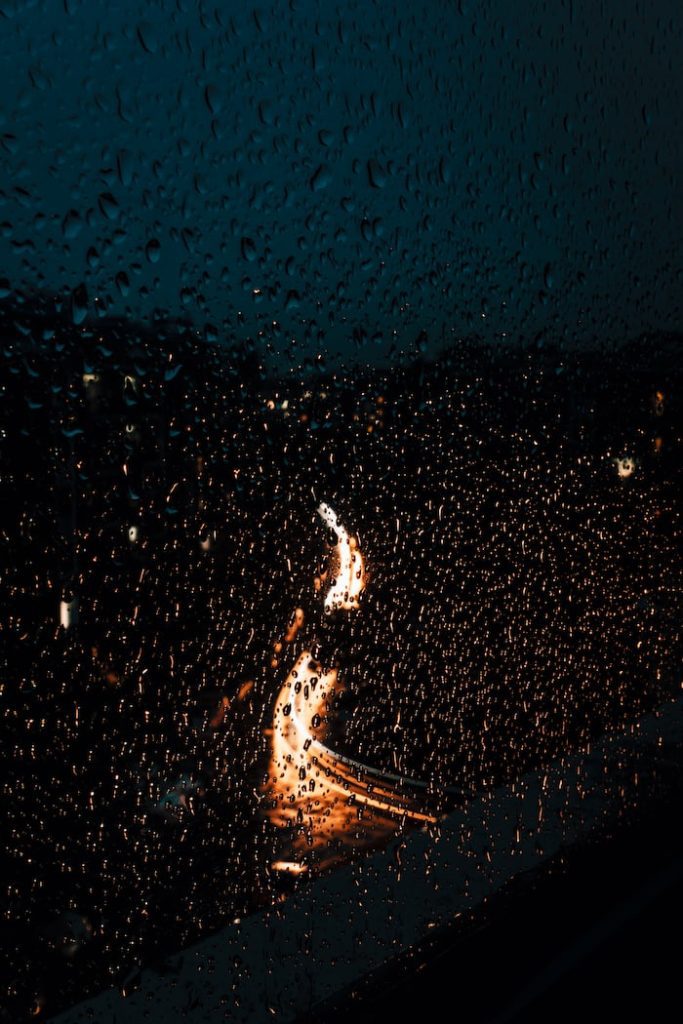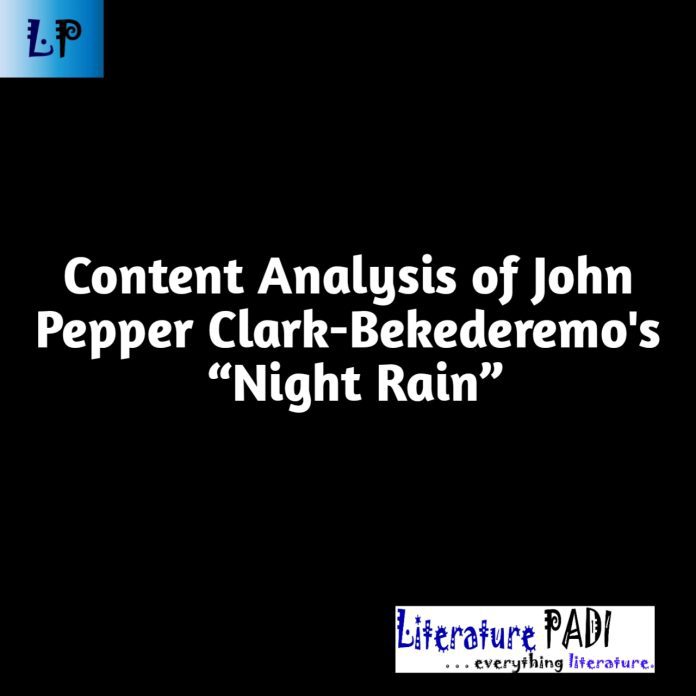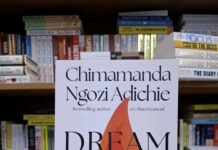📢 Follow our WhatsApp Channel for the latest literary updates!
In “Night Rain,” John Pepper Clark-Bekederemo explores the experience of a poor family living in a riverine area through the perspective of a young boy. The poem intertwines description and narration, vividly portraying an ongoing rainfall and its immediate impact on the specific family.
The imagery employed, particularly the references to fishing and the mention of the sea, indicates that the setting of the poem is in a riverine area. This location is susceptible to the kind of heavy rainfall depicted in the poem. The family at the center of the narrative is undeniably impoverished, residing in a house with a roof made of rool thatch, which is “slit open” (line 12), exposing them to the perils of lightning and rain.
Consequently, the mother of the household has grown accustomed to waking up whenever it rains at night to safeguard their meager belongings from the leaking roof. The family’s utensils consist of “wooden bowls and earthenware” (line 21), while the children sleep on “loosening mats” (line 32). They inhabit a small roomlet (line 23).
The poem effectively establishes both the physical riverine setting and the pervasive atmosphere of poverty. Despite their challenging circumstances, there is a sense that the children have adapted to their situation, and the rainfall itself has a calming and soothing effect on them.
Structure
“Night Rain” is structured as a single continuous stanza consisting of forty-seven lines.
The poem primarily adopts a free verse style, lacking a definite rhyme scheme. However, there are occasional incidental rhymes, such as ‘deep’/’sleep’ (lines 4-6), ‘here’/’everywhere’ (lines 7 and 9), and ‘stand’/’and’ (lines 37 and 38). The final four lines of the poem notably end as couplets with the words ‘land’/’hand’ (lines 44 and 45) and ‘sea’/’free’ (lines 46 and 47).
Although these rhymes may be coincidental, they contribute to the overall musicality of the piece. The lines vary in length, with the longest one appearing at the end, hinting at the concept of ‘freedom.’
Additionally, the poem contains several instances of run-on lines (enjambments) where the idea initiated in one line carries over to the next. In fact, there are only eight full-stops throughout the entire poem, emphasizing the seamless flow of ideas between them. This continuous structure aligns with the ongoing description of the rainfall. Moreover, it complements the frequent use of continuous verb forms. These elements—form, content, and structure—are skillfully harmonized in the poem.
Line by Line Summary
The first seven lines of the poem depict the poet-persona being awakened from a deep sleep by the sound of rain in the silent hours of the night.
From lines 8 to 14, the poem portrays the powerful rhythm of the rain accompanied by flashes of lightning, visible through the openings in the thatched roof.

Lines 15 to 21 describe the raindrops that enter the room through the damaged roof. The poet compares them to falling fruits like oranges or mangoes, as well as to prayer beads, emphasizing their speed and size.
In lines 22 to 30, the poem vividly portrays the mother’s adeptness in managing the leaking roof. She skillfully moves her belongings away from the water flowing across the floor, showcasing her experience and practiced movements.
Lines 30 to 41 delve into the impact of the night rain on the poet-persona and his brothers. They seem to have absorbed a profound enchantment, deeper than that of the thoroughly drenched owl or bat perched on the iroko tree. The rain has left them feeling “Emptied of hearts” (line 38).
Concluding the poem in lines 42 to 47, the poet-persona attempts to return to sleep, experiencing the innocent and liberating slumber of the free. They find solace under the gentle and comforting touch of the rain’s abundant presence. The poet and his brothers will surrender themselves to the pleasurable sensation of rolling over to the rhythmic drumming of the rain, which encompasses the entire land.
Language Style
The language used in “Night Rain” employs various poetic devices to enhance its impact and convey intended meanings. The prominent features include the use of present continuous verbs, alliteration, metaphor, assonance, simile, diction, repetition, hyperbole, and personification. Let’s examine each device in the context of the poem:
The use of present continuous verbs, such as ‘drumming,’ ‘droning,’ and ‘soothing,’ emphasizes the persistence and continuity of the rain throughout the night.
Alliteration, such as ‘Doped out of the deep,’ ‘bobbed up bellywise,’ and ‘stream of sleep,’ adds to the poem’s rhythm and captures the sound and flow of rainfall.
Metaphor is employed in phrases like ‘Doped out of the deep’ and ‘bobbed up bellywise,’ creating imagery of awakening from a deep sleep, akin to a fish rising to the surface. The rain is metaphorically described as ‘drumming’ and the mother’s actions are metaphorically compared to troop deployment in war.
Assonance, seen in phrases like ‘bobbed up,’ ‘bags, and vats,’ and ‘tremble then,’ enhances the musicality and rhythm of the poem.
Similes, such as ‘like some fish’ and ‘falling like orange or mango fruits,’ vividly describe the poet’s awakening and the raindrops, respectively. The image of water drops ‘like beads’ is also evoked.
Carefully chosen diction, including ‘practised step,’ ‘bedraggled,’ and ‘insistent ardour,’ adds specific and effective meaning to the poem.
Repetition is employed in phrases like ‘turn, brothers, turn’ and ‘roll,’ emphasizing certain actions or ideas.
Hyperbole is used when comparing the impact of the rain on the poet-persona and his brothers to that on the thoroughly drenched owl and bat, exaggerating their experience.
Personification is employed when the rain is described as having an ‘ample soothing hand,’ presenting it as someone comforting and lulling the children to sleep.
These poetic devices work together to create a powerful and evocative poem, enhancing its effectiveness in conveying the experience of the night rain and the emotions associated with it.
Join Our Social Media Channels:
- WhatsApp: Literature PADI
- Telegram: Literature PADI
- YouTube: @literaturepadi
- Facebook: Literature PADI












it was very helpful for my research. tnx